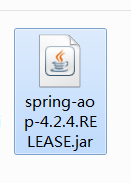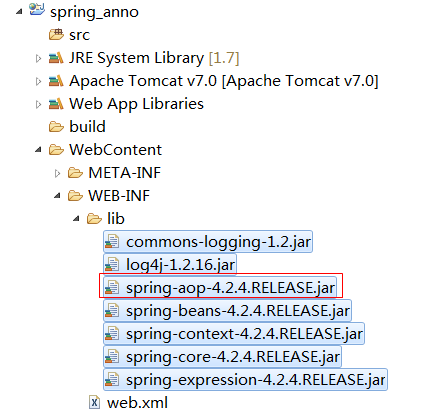一、环境搭建
1、创建web项目导入jar包
注意:基于注解的配置需要导入aop的支持包:spring-aop-4.2.4.RELEASE.jar
2、创建spring配置文件
<?xml version="1.0" encoding="UTF-8"?>
<!-- 导入约束:
除了要导入第一天的约束之外,还要导入context的名称空间和约束
-->
<beans xmlns="http://www.springframework.org/schema/beans"
xmlns:xsi="http://www.w3.org/2001/XMLSchema-instance"
xmlns:context="http://www.springframework.org/schema/context"
xsi:schemaLocation="http://www.springframework.org/schema/beans
http://www.springframework.org/schema/beans/spring-beans.xsd
http://www.springframework.org/schema/context
http://www.springframework.org/schema/context/spring-context.xsd">
</beans>3、使用@Component注解配置管理的资源
@Component
它就相当于在配置文件中配置了一个bean标签。
value属性用于指定bean的id
如果没有指定value属性,bean的id就是当前类的名称,首字母改小写。
import org.springframework.stereotype.Controller;
import org.springframework.stereotype.Repository;
import cn.itcast.dao.ICustomerDao;
/**
* 客户的持久层实现类
*
* <bean id="customerDao" class="cn.itcast.dao.impl.CustomerDaoImpl"></bean>
*
* @Component
* 它就相当于在配置文件中配置了一个bean标签。
* value属性用于指定bean的id
* 如果没有指定value属性,bean的id就是当前类的名称,首字母改小写。
* <bean id="customerDaoImpl" class="cn.itcast.dao.impl.CustomerDaoImpl"></bean>
*/
@Repository(value="customerDao1")
public class CustomerDaoImpl implements ICustomerDao {
@Override
public void saveCustomer() {
System.out.println("保存了客户。。。。。11111111111111111111111");
}
}4、在spring配置文件中开启对注解的支持
<!-- 告知spring,在创建容器时,要扫描的包 -->
<context:component-scan base-package="cn.itcast"></context:component-scan>5、读取配置文件,创建对象
import org.springframework.context.ApplicationContext;
import org.springframework.context.support.ClassPathXmlApplicationContext;
import cn.itcast.service.ICustomerService;
import cn.itcast.service.impl.CustomerServiceImpl;
public class Client {
public static void main(String[] args) {
//1.获取Spring容器
ApplicationContext ac = new ClassPathXmlApplicationContext("bean.xml");
ICustomerDao cs1 = (ICustomerDao) ac.getBean("customerDao1");
System.out.println(cs1);
}
}二、常用的注解
1、用于创建对象的注解
相当于:<bean id="" class="">
@Component
作用:把资源让spring来管理。相当于在xml中配置一个bean。
属性:value:指定bean的id。如果不指定value属性,默认bean的id是当前类的类名。首字母小写。
@Controller @Service @Repository
他们三个注解都是针对一个的衍生注解,他们的作用及属性都是一模一样的。 他们只不过是提供了更加明确的语义化。
@Controller:一般用于表现层的注解。
@Service:一般用于业务层的注解。
@Repository:一般用于持久层的注解。
细节:如果注解中有且只有一个属性要赋值时,且名称是value,value在赋值是可以不写。
2、用于注入数据的注解
相当于:<property name="" ref=""> <property name="" value="">
@Autowired
作用:
自动按照类型注入。当使用注解注入属性时,set方法可以省略。它只能注入其他bean类型。当有多个类型匹配时,使用要注入的对象变量名称作为bean的id,在spring容器查找,找到了也可以注入成功。找不到就报错。
@Qualifier
作用:
在自动按照类型注入的基础之上,再按照Bean的id注入。它不能独立使用,必须和@Autowire一起使用。
属性:
value:指定bean的id。
@Resource
作用:
直接按照Bean的id注入。它也只能注入其他bean类型。
属性:
name:指定bean的id。
@Value
作用:
注入基本数据类型和String类型数据的
属性:
value:用于指定值
public class CustomerServiceImpl implements ICustomerService {
/**用于注入其他bean类型的
* @Autowired
* 作用:自动按照类型注入。set方法可以不写。
* 如果没有匹配的类型,则报错。
* 如果有多个匹配的情况,它会使用变量的名称作为bean的id,如果能找到,依然可以注入成功。如果再找不到,就报错。
* @Qualifier
* 作用:在自动按类型注入的基础之上,再按照bean的id注入
*
* @Resource
* 作用:直接按照bean的id注入。
*
* 用于注入基本数据类型
* @Value
* 作用:注入基本类型和String类型数据
*
*/
// @Autowired
// @Qualifier(value="customerDao1")
@Resource(name="customerDao2")
private ICustomerDao customerDao;
@Value(value="com.mysql.jdbc.Driver")
private String driver;
@Value(value="jdbc:mysql://localhost:3306/spring_day02")
private String url;
@Value(value="root")
private String username;
@Value(value="1234")
private String password;
@Override
public void saveCustomer() {
System.out.println(driver);
System.out.println(url);
System.out.println(username);
System.out.println(password);
customerDao.saveCustomer();
}
/**
* Autowired 注解的实现原理
*
*/
public static void main(String[] args) {
Class clazz = CustomerServiceImpl.class;
Field[] fs = clazz.getDeclaredFields();
for(Field f : fs){
boolean b = f.isAnnotationPresent(Autowired.class);
if(b){
Class c = f.getType();
System.out.println(c);
}
}
}
}3、用于改变作用范围的注解
@Scope
作用:
指定bean的作用范围。
属性:
value:指定范围的值。
取值:
singleton
prototype
request
session
globalsession
4、与生命周期相关的注解
相当于:<bean id="" class="" init-method="" destroy-method="" />
@PostConstruct
作用:
用于指定初始化方法。
@PreDestroy
作用:
用于指定销毁方法。
5、代码演示
业务层代码:
/**
* 客户的业务层接口
* @author zhy
*/
public interface ICustomerService {
/**
* 保存客户
* @param customer
*/
void saveCustomer();
}
/**
* 客户的业务层实现类
* @author zhy
*
*/
//作用就相当于在xml中配置了一个bean标签,该注解有value属性,含义是bean的id。
//不写的时候,默认的id是:当前类名,且首字母小写。即:customerServiceImpl
@Component(value="customerService")
@Scope(value="singleton")
public class CustomerServiceImpl implements ICustomerService {
// 自动按照数据类型注入,拿着当前变量的数据类型在spring的容器中找,找到后,给变量赋值。
// 当有多个类型匹配时,会使用当前变量名称customerDao作为bean的id,继续在容器中找。
// 找到了,也能注入成功。找不到就报错。
// @Autowired
// @Qualifier(value="customerDao2")//在自动按照类型注入的基础之上,再按照id注入
@Resource(name="customerDao2")//直接按照bean的id注入
private ICustomerDao customerDao = null;
@Value("com.mysql.jdbc.Driver")//注入基本类型和String类型数据
private String driver;
@Override
public void saveCustomer() {
System.out.println(driver);
customerDao.saveCustomer();
}
}
持久层代码:
/**
* 客户的持久层接口
* @author zhy
*/
public interface ICustomerDao {
/**
* 保存客户
*/
void saveCustomer();
}
/**
* 客户的持久层实现类11111111111111111111
* @author zhy
*
*/
@Repository("customerDao1")
public class CustomerDaoImpl implements ICustomerDao {
@Override
public void saveCustomer() {
System.out.println("保存了客户111111111111111111");
}
}
/**
* 客户的持久层实现类222222222222222222222222
* @author zhy
*
*/
@Repository("customerDao2")
public class CustomerDaoImpl2 implements ICustomerDao {
@Override
public void saveCustomer() {
System.out.println("保存了客户2222222222222222222");
}
}
测试类代码:
public class Client {
public static void main(String[] args) {
//1.获取容器
ApplicationContext ac = new ClassPathXmlApplicationContext("bean.xml");
//2.根据id获取对象
ICustomerService cs = (ICustomerService) ac.getBean("customerService"); cs.saveCustomer();
}
}
配置文件:
<?xml version="1.0" encoding="UTF-8"?>
<!-- 我们导入约束时,除了昨天的那部分之外,还要单独导入一个context名称空间 -->
<beans xmlns="http://www.springframework.org/schema/beans"
xmlns:xsi="http://www.w3.org/2001/XMLSchema-instance"
xmlns:context="http://www.springframework.org/schema/context"
xsi:schemaLocation="http://www.springframework.org/schema/beans
http://www.springframework.org/schema/beans/spring-beans.xsd
http://www.springframework.org/schema/context
http://www.springframework.org/schema/context/spring-context.xsd">
<!-- 告知spring框架在通过读取配置文件创建容器时,扫描的包,并根据包中类的注解创建对象-->
<context:component-scan base-package="com.itheima"></context:component-scan>
</beans>
6、关于xml和注解的选择的配置
注解的优势:
配置简单,维护方便(我们找到类,就相当于找到了对应的配置)。
XML的优势:
修改时,不用改源码。不涉及重新编译和部署。
三、spring的纯注解配置
1、配置注解类 -- 配置要扫描注解的包
package cn.itcast.config;
import org.springframework.context.annotation.ComponentScan;
import org.springframework.context.annotation.Configuration;
import org.springframework.context.annotation.Import;
import org.springframework.context.annotation.PropertySource;
/**
* 此类就是一个配置类,用于让spring读取该类上的注解用的
*
* @Configuration
* 作用:告知spring此类是一个配置类
* @ComponentScan
* 作用:指定spring在创建容器时要扫描的包
* 属性:
* value:指定要扫描的包名称。作用和basePackages是一模一样的。
*/
@Configuration
@ComponentScan({"cn.itcast"})
public class Configuration_A {
}2、测试类
import javax.sql.DataSource;
import org.springframework.context.ApplicationContext;
import org.springframework.context.annotation.AnnotationConfigApplicationContext;
import cn.itcast.config.Configuration_A;
public class Client {
public static void main(String[] args)throws Exception {
//1.获取Spring容器,参数是配置类的字节码文件
ApplicationContext ac = new AnnotationConfigApplicationContext(Configuration_A.class);
ICustomerService cs1 = (ICustomerService) ac.getBean("customerService");
cs1.saveCustomer();
}
}3、引入其他配置类的做法
@Import
(1)、被引入的配置类
package cn.itcast.config;
import javax.sql.DataSource;
import org.springframework.beans.factory.annotation.Value;
import org.springframework.context.annotation.Bean;
import com.mchange.v2.c3p0.ComboPooledDataSource;
/**
* @author winghze
*/
@Component("jdbcConfig")
public class JDBCConfig {
@Value("com.mysql.jdbc.Driver")
private String driver;
@Value("jdbc:mysql://localhost:3306")
private String url;
@Value("root")
private String username;
@Value("1234")
private String password;
/**
* 用于创建一个C3P0连接池
* @return
* @throws Exception
*
*
*/
public DataSource createDataSource() throws Exception{
ComboPooledDataSource ds = new ComboPooledDataSource();
ds.setDriverClass(driver);
ds.setJdbcUrl(url);
ds.setUser(username);
ds.setPassword(password);
return ds;
}
}(2)、引入配置类的配置类
import org.springframework.context.annotation.ComponentScan;
import org.springframework.context.annotation.Configuration;
import org.springframework.context.annotation.Import;
import org.springframework.context.annotation.PropertySource;
/**
* 此类就是一个配置类,用于让spring读取该类上的注解用的
* @author zhy
*
* @Configuration
* 作用:告知spring此类是一个配置类
* @ComponentScan
* 作用:指定spring在创建容器时要扫描的包
* 属性:
* value:指定要扫描的包名称。作用和basePackages是一模一样的。
* @Import
* 作用:导入其他带有注解的类
*/
@Configuration
@ComponentScan({"cn.itcast"})
@Import({JDBCConfig.class})
//@PropertySource("classpath:/cn/itcast/config/jdbc.properties")
public class Configuration_A {
}(3)、测试类
import javax.sql.DataSource;
import org.springframework.context.ApplicationContext;
import org.springframework.context.annotation.AnnotationConfigApplicationContext;
import cn.itcast.config.Configuration_A;
public class Client {
public static void main(String[] args)throws Exception {
//1.获取Spring容器
ApplicationContext ac = new AnnotationConfigApplicationContext(Configuration_A.class);
JDBCConfig jc = (JDBCConfig) ac.getBean("jdbcConfig");
DataSource ds = jc.createDataSource();
System.out.println(dc.getConnection());
}
}4、spring3以后的新注解说明
@Configuration
作用:
用于指定当前类是一个配置类,相当于把当前类看成是配置文件,会从该类上加载注解。读取该类上@ ComponentScan注解初始化spring容器。
@ComponentScan
作用:
用于指定spring在初始化容器时要扫描的包。
属性:
basePackages:用于指定要扫描的包。和该注解中的value属性作用一样。
@PropertySource
作用:
用于加载.项目下的properties文件中的配置
属性:
value[]:用于指定properties文件位置。如果是在类路径下,需要写上classpath;
示例代码:
(1)、配置文件类
@Configuration
@ComponentScan(basePackages = "cn.itcast.spring")
@PropertySource("classpath:info.properties")//加载类路径下的properties文件
public class Configuration_A {
}(2)、实体类
@Component("car")
public class Car {
private String id ;
@Value("${car.name}")//此时是读取properties文件,根据key取value了。
private String name ;
@Value("${car.price}")//此时是读取properties文件,根据key取value了。
private Double price ;
public String getId() {
return id;
}
public void setId(String id) {
this.id = id;
}
public String getName() {
return name;
}
public void setName(String name) {
this.name = name;
}
public Double getPrice() {
return price;
}
public void setPrice(Double price) {
this.price = price;
}
@Override
public String toString() {
return "Car [id=" + id + ", name=" + name + ", price=" + price + "]";
}
}(3)、properties配置文件
car.name = \u4FDD\u65F6\u6377//中文是保时捷
car.price = 1000000@Import
作用:
用于导入其他配置类
属性:
value[]:用于指定其他配置类的字节码。
示例代码:
(1)、配置类
@Configuration
@ComponentScan(basePackages = "cn.itcast.spring")
@Import({ Configuration_B.class})
public class Configuration_A {
}@Configuration
@PropertySource("classpath:info.properties")
public class Configuration_B {
}@Bean
作用:
该注解只能写在方法上,表明使用此方法创建一个对象,并且交给spring管理。简单理解为,创建对象的由自己控制,但是创建完成的对象交给spring来管理,可以使用getBean()方法获取自己创建的对象。
属性:
name:给当前@Bean注解方法创建的对象指定一个名称(即bean的id)。
示例代码:
@Bean(name = "datasource2")
public DataSource createDS() throws Exception {
ComboPooledDataSource comboPooledDataSource = new ComboPooledDataSource();
comboPooledDataSource.setUser("root");
comboPooledDataSource.setPassword("1234");
comboPooledDataSource.setDriverClass("com.mysql.jdbc.Driver");
comboPooledDataSource.setJdbcUrl("jdbc:mysql:///spring_ioc");
return comboPooledDataSource;
}


























 343
343

 被折叠的 条评论
为什么被折叠?
被折叠的 条评论
为什么被折叠?








